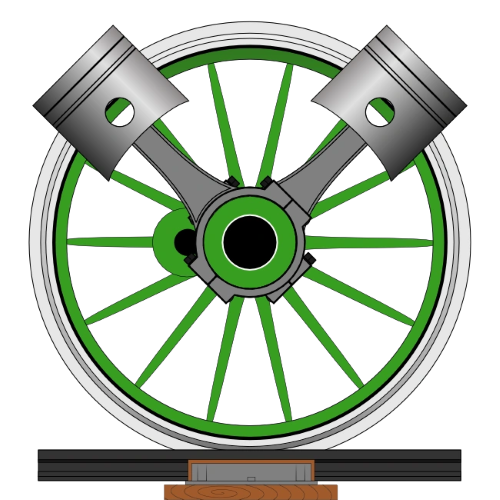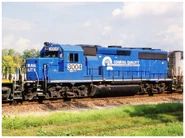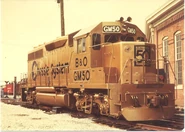The Electro Motive Division GP40 was a four-axle 3,000hp diesel locomotive built from 1965 to 1971.
While some have since been scrapped, many GP40's continue in service as of today, either in their original form or rebuilt to other specifications.
Many were built and purchased by various different railroads.
History
The EMD GP40 began as a four-axle diesel locomotive originally intended for freight service, and was one of a series of models introduced in 1966 with the introduction of the EMD 645-series engine. It used a turbocharged 16-cylinder version of the engine and was built alongside the GP38 (with a Roots-blown 16-cylinder engine) and the GP39 (with a turbocharged 12-cylinder engine). All three which were built to GP35 expectations; aside from serving as an initial replacement. The SD38, SD39, SD40 and SD45 were contemporary six-axle models of the series.
The high-horsepower GP40 often struggled while hauling long and heavy freight trains because of its adhesion problems. This was mostly solved by the GP40-2.
While the GP40 shared many components with the GP35 (as well as the GP38 and GP38-2), a simplified electrical system and the introduction of an alternator-rectifier system (replacing the DC generator) improved reliability. The 16-cylinder 645 engine subsequently gained a reputation for reliability and solid performance. The GP40 was a sales success, selling over 1,200 units over its production run. It was discontinued and replaced by the GP40-2 (its "Dash 2" series upgrade) in 1972.
In early 2014 one UP GP40 was rebuilt by EMD into a GP59ECO mated to a slug.
Specifications
The GP40 is 59' 2" long, weighs 245,000 lbs (subject to railroad specifications) and develops a total of 54,700 lbs of continuous tractive effort at 11.1 mph. Power was provided by a 3,000 horsepower, 16-cylinder 645E3 engine connected to an AC alternator, with the output rectified to supply four DC traction motors. Dynamic brakes (identified by a single central fan and canted intake) were optional but present on much of the production total.
Compared to other EMD models of the same era, the GP40 can be identified by a B-B wheel arrangement, a single exhaust stack, three 48" radiator fans at the rear of the hood and a 1-2-4 door arrangement under the radiator intakes. The later GP40-2 received numerous modifications, with the most obvious visual differences being revised door spacing, bolted battery boxes (hinged on the GP40) and the oblong water-level sight glass near the rear of the hood (absent on the GP40).
Variants
- GP40TC: A GP40 with an HEP generator, that is built on an SD40 frame. It can be easily identified by its short nose and its length. The "TC" stood for "Toronto Commuter," and only GO Transit has purchased these locomotives. They were numbered 600-607, and were sold to Amtrak when GO recieved their first F59PH order. They continue in service today as Amtrak as 520-527, rebuilt into GP38H-3 units.
- GP40FH: A locomotive with the running gear and cab of a GP40 and a cowl body from an F45. It was built by MK Rail for New Jersey Transit. It is equipped with HEP.
- GP40P/GP40PH: Passenger versions of the GP40 built for Central New Jersey. Initially equipped with a steam generator, but were later rebuilt with diesel HEP generators, and re-classed as GP40PHs. Some later GP40 conversions are also called "GP40PH." Most are with NJ Transit
- GP40WH-2: GP40s built by MK Rail for MARC of Maryland. It has a Cummins HEP generator for powering commuter trains. All have been sold to MotivePower Industries (the successor of MK Rail) and are being rebuilt into MP32PH-Q units for SunRail.
- GP40MC: Formerly GP40-2Ws built for CN, rebuilt with an HEP generator and sold to MBTA of Boston.
Production totals
- ARR: (QTY:15) #'s 3000-3005,3007-3015
- B&O (QTY:218) #'s GM50, 4100-4162,1977, 4185-4256, 4287-4311, 4322-4351, 4422-4447.
- B&M (QTY:18) #'s 300-317
- C&O (QTY:95) #'s 4165-4184,4267-4281, 4372-4412
- Ferrrocarril Chihuahua al Pacifico (QTY:29) #'s 1008-1036
- Conrail (QTY:129) #'s 3275-3403
- DRGW (QTY:37) #'s 3094-3130
- CN (268)
- GO (11 -2W and 7 GP40s) #700-710, 720-726
Trivia
Railroads such as the Baltimore And Ohio (B&O) primarily used their fleets of GP40 units on heavy coal drag service through the Allegheny Mountain range in the Eastern US. Most have survived into the CSX system, but now currently serve as yard and branchline units.
There are also several foreign versions of the GP40, but are often different locomotive models built with GP40 parts.
SCRX (South Carolina Railway Association Leasing) GP40 #3134 is a former D&RGW GP40 (aside from being owned by previous leasers) which starred in several films; such as the Fast and Furious and Evasive Action; and remained in its original patched scheme until around 2010 when it was purchased by an industrial company. It is considered to be Sierra Railway No. 3's diesel locomotive counter-part.
BNSF (Burlington Northern and Santa Fe railway) has rebuilt several GP35's GP30's, and GP40's into GP39E's or GP39-2E's.
Commuter railroads, such as MARC, GO (Government of Ontario) Transit, and NJ (New Jersey) Transit, have had modified and rebuilt passenger versions of the GP40. Most are still in service, some as freight locomotives, some sold to other agencies/Amtrak.
Several various GP40-2 units have also been re-rated or downgraded to GP38-2 specifications, or have simply become such.
Gallery
Sources

GP38-2S Idling EXTENDED VERSION
CSX #4427 (a de-rated GP40-2 classified as a GP38-2S) idling.




